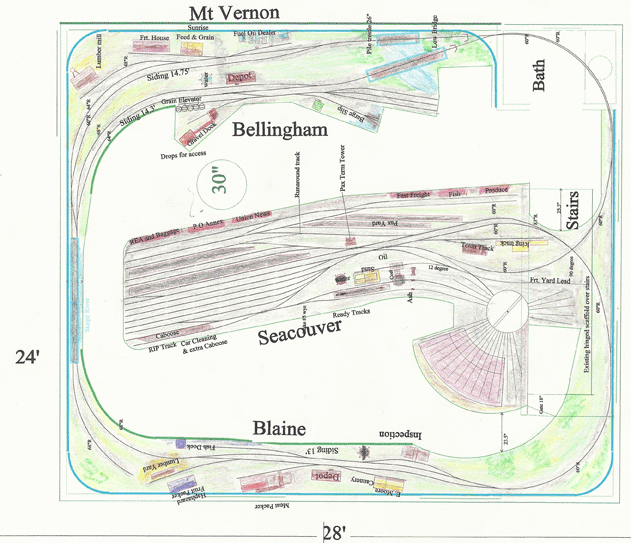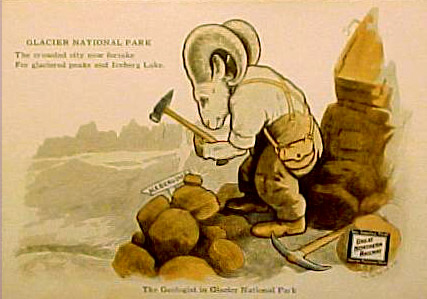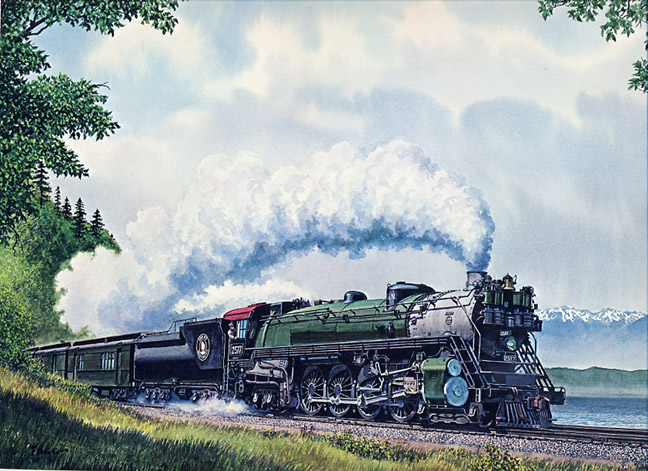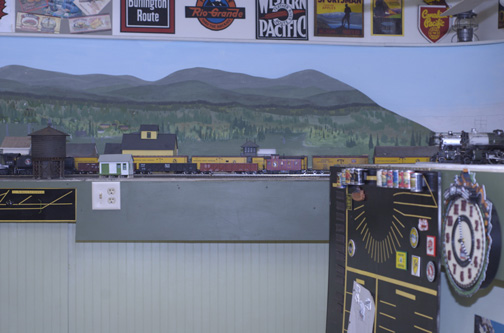Current Model Railway
2008 -

Progress Pictures
My model railroad, called the The Great Nothing, is 1/4' scale pike that has occupied the 27.5' X 23.5' space above the garage since 1987. The Great Nothing is the fifth O scale incarnation in this space. It is being built at eye level to watch and hear big steam power handle mainline consists. The recurring theme is big time mainline railroading set in the Pacific Northwest when both steam and electric ruled the rails. The emphasis of the current pike is operating, both passenger and freight trains, using card waybills. The period modeled, the late thirties, is the pinnacle of the steam era when heavyweight equipment was used on all passenger trains, all modern classes of steam locomotives were developed, and GN took pride in its equipment, best illustrated by the glossy green and black of its steam locomotives.
Layout
 |
The Great Nothing! A new adventure begins!
Prototype
The Great Nothing models the 155 mile Great Northern mainline between Seattle and Vancouver, in the Pacific Northwest. It is almost level the entire way. The first thirty miles to Everett ran along the shore of Puget Sound, was double tracked and a part of GN's transcontinental main line. The rest of the way was single tracked passing through rich farm land and stands of timber. Across the border, Canadian National had trackage rights on the GN to reach Vancouver. Great Northern had the only direct line between the two seaport cities. Four other seaports; Everett, Anacortes, Bellingham, WA and New Westminster BC generated more GN freight traffic as did several smaller farming, lumbering, and fishing communities. The time period is 1939-1941, just before the US entered WWII but after Canada did. It was 100% steam and the war brought an explosion in freight and passenger traffic. Four daily passenger trains ran each way. The INTERNATIONAL was the flagship, carrying mail and express, an unreserved coach, reserved seat air conditioned coach, a diner and bringing up the markers a parlor-lounge-observation. The CANADIAN (northbound) - AMERICAN (southbound) was the other day train. It carried the same consist as the INTERNATIONAL except parlor lounge observation. The OWL the night train carried a heavy headend load, a coach, and Pullman sleepers. Finally, a 2 or 3 car local stopping at every station that displayed a flag.
The daily scheduled manifest freight train was called the SEABOARD. Most freight however moved as extras or on local way freights.
Model Railway- Design
Double deck layouts don't appeal to me, one level always seems to low or too high, besides much of the realism is lost by the train spiraling up the helix. I feel a track plan instead should be drawn to capture the drama of the flow of trains. That means an active terminal, a busy mainline replete with passing sidings and local industry spurs are needed.
I am not a fanatic about 'sincere' track planning meaning a train only passes through a scene once. On the other hand, I did not want a 'spaghetti bowl'. I wanted to be able walk along side the train was running, have the turnout controls on the fascia by the switch, and locations for passenger and freight switching.This version features wider aisles, more industries for switching and a larger and more accessible engine terminal. I drew on ideas of many others in designing this layout. For example, the scissors wye idea was lifted directly from an Armstrong design, although the rest of the terminal trackage is mine. On The Great Nothing, a single main terminal, Seacouver, represents for both ends of the run. It consists of a passenger depot, freight yard and engine terminal. The twice around mainline has three towns, Blaine, Bellingham, and Mt. Vernon plus a five track staging yard, called Everett that is not depicted on the plan. Two tracks are stacked on each other as they pass through the bathroom. The track from Bellingham is the lower level through the bath and goes to Everett, the double ended five track staging yard. Then the line re-emerges to the left of Blaine on the plan and continues to Mt. Vernon and then becomes the upper track in the bath and on to Seacouver.
Each leg of the wye carries a different name, Seattle and Vancouver, to capture the idea of distance. Besides the switching possibilities at the three towns, the terminal also offers switching in the form of making and breaking trains and spotting cars at several spurs. Of course, if one is in a train watching mode, the bottom of the wye can be used for through trains. During operating sessions, if the yard backs up, the wye can be used to turn trains instead of switching.
The Great Nothing designed for DCC split into four zones. The system of choice is CVP's Easy DCC with walk around throttles. Most of the turnouts in the terminal area will be controlled by DCC decoders. This will allow a route from either approach track to any terminal track to be aligned with a single command. There is a toggle to change to straight DC so that visitors may bring thier locos to run and for my locos that are still not converted to DC. Many locomotives are already equipped with Tsunami decoders. Since the high amp Tsunamis are not yet available, 6 locomotives have dual decoders, a high amp decoder for the motor and Tsunami for sound.
The mainline has a 60” minimum radius, although I was shooting for a 68" minimum and the maximim grade is 1.7%. Right-O-Way switch components are being used with the Tortoise switch machines.
Model Railway- Operations
The pike is the time honored out and back scheme with mainline wrapped around the room twice. By looping the mainline twice around the room, some running space between the towns has been gained. Keeping trains to lengths that fit in the sidings allows constant action on the main. It has a compressed urban terminal, three towns with passing sidings and four hidden holding tracks. A wye at the head of the terminal serves two functions. It permits continous running during open houses or when breaking in a locomotive. Second, it permits turning of passenger consists without having to break down the train. This follows GN practice which used a wye at both Vancouver and Seattle to turn passenger consists. The ubiquitous car forwarding system with each freight having a card and changeable four destination waybill is planned for all freight movements. Both the towns and terminal are places for freight switching. Passenger and freight trains are made up and split up at the terminal. The five track staging yard is called Everett. Trains held there are used to store cars that have 'forwarded' to other points.
Traffic
Medium sized motive power was all that was necessary to handle the bustling traffic of the period. Pacifics saw dual service and during holidays might handle a dozen or more passenger cars. Lighter Mikes handled 60-75 car freights and Consolidations handled long way freights. If we want to run the line like the prototype, the length of our trains has to scaled back. Train length is determined by what will fit in the shortest siding.
Passenger
As noted above, the INTERNATIONAL carried headend car(s), an unreserved coach, reserved seat air conditioned coach, a diner and a parlor-lounge-observation. The CANADIAN - AMERICAN carried the same consist as the INTERNATIONAL except parlor lounge observation. The OWL the night train carried a heavy headend load, a coach, and Pullman sleepers. Finally there was a 2 or 3 car local.
One train consist and some extra equipment from the coach yard can be used to model the above four trains. Lets start the cycle with the INTERNATIONAL, probably the longest train. It is made up in the terminal by the yard goat assigned to the passenger side. A Pacific, fresh from the roundhouse couples on and it departs. The train makes a loop around the main and returns via the opposite leg of the wye. The Pacific goes to the roundhouse. The yard goat, cuts off the observation, placing it in the coach yard and then turns the remaining consist on the wye. With a new engine it departs as the AMERICAN/CANADIAN over the same leg of the wye it arrived on. The goat adds and subtracts cars from the coach yard with each arrival creating the four different trains. Occasionally, an express reefer is added. It is dropped at the fruit packer in Mt. Vernon and picked up by the next trip. In the 20s and 30s GN cut of the diner at Blaine northbound and picked it up on the southbound trip. In that period a 12-1 sleeper was operated between Seattle and Bellingham. Although neither were being done by 1941, they add would variety when running passenger trains.
Freight
The three basic types of freight train, the manifest, the drag, and the peddler. For operational purposes, the manifest and drag are two sides of the same coin. Both are assembled at the terminal and either runs the main without stopping and returns to the terminal or lays over in the Everett holding yard. Both carry cars whose waybill indicates a destination on another road or the eastern part of the GN. After its arrival the waybills are turned for a new destination. The difference is the manifest is a fast freight and carries cars are appropriate for a expedited service. The long and slow drags operate the same as the manifests but with all cars not suitable for the manifest. While the Everett tracks can handle the drags, they often are too long for the sidings so meets consist of a saw-by. Departing or arriving at the terminal they double over on two tracks.
Peddlers account for the lion's share of switching traveling the main and as expected, working local industry spurs at the three towns. Mt Vernon industries represent surrounding dairy and berry farms. The lumber mill is painted on the backdrop, is representative of so many along the right-o-way. Bellingham has a barge slip that provides a generous amount of switching and a means to rotate cars on and off the layout. Blaine is a border town with a surprising amount of work for the peddler. Besides the small industry spurs, all southbound trains stop for Customs inspection and northbound to file export declarations. The same occurs on the Canadian side at the not modeled town of White Rock. There are stock pens where cattle are unloaded to be inspected and weighted. Occasionally a shipment lacks entry papers and must be dropped on the house track.
| (click sketch to view) |






